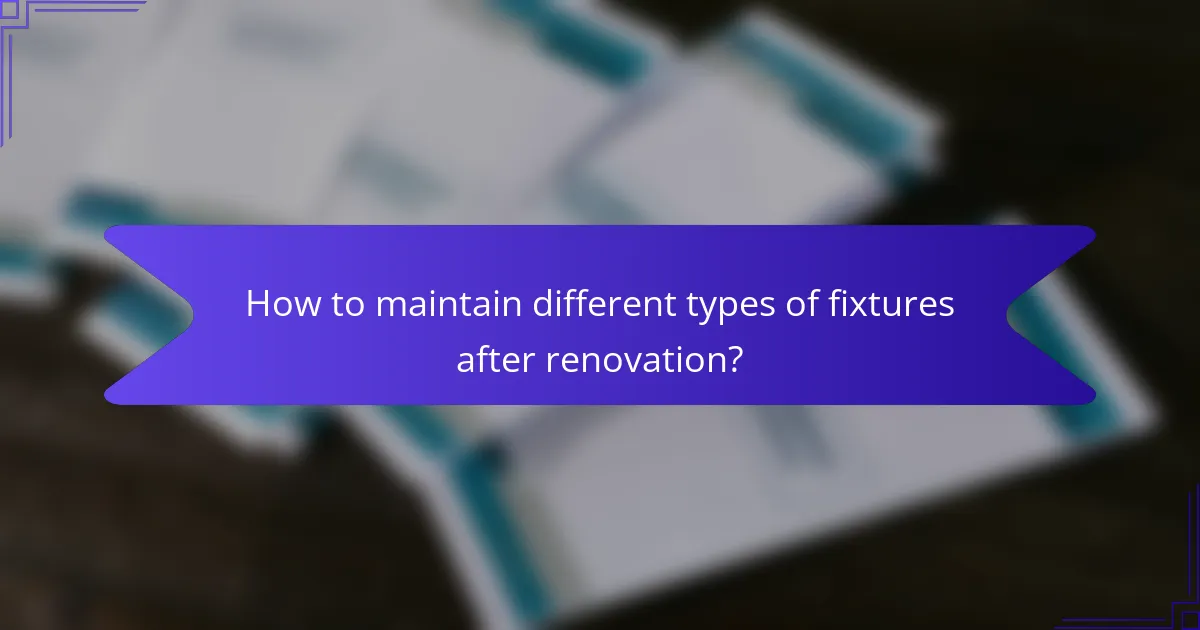Post-renovation fixtures require diligent care and maintenance to ensure their longevity and optimal performance. By implementing effective cleaning techniques and adhering to a consistent maintenance schedule, homeowners can preserve the functionality and aesthetics of their fixtures. Understanding the expected lifespan of various materials can also guide proper upkeep, helping to maximize the investment made in renovations.

What are the best care practices for post-renovation fixtures in South Africa?
To ensure longevity and optimal performance of post-renovation fixtures in South Africa, regular care and maintenance are essential. This involves implementing effective cleaning techniques, using appropriate products, and adhering to a consistent maintenance schedule.
Regular cleaning techniques
Regular cleaning is crucial for maintaining the appearance and functionality of fixtures. Use a soft cloth or microfiber towel to gently wipe surfaces and avoid scratching. For hard-to-reach areas, consider using a small brush or vacuum attachment to remove dust and debris.
For bathroom and kitchen fixtures, a mixture of warm water and mild soap can effectively remove grime without damaging finishes. Always follow the grain of the material when cleaning to prevent wear.
Recommended cleaning products
Opt for pH-balanced cleaners that are specifically designed for the materials of your fixtures, such as stainless steel or ceramic. Avoid harsh chemicals that can cause corrosion or discoloration.
Some recommended products include vinegar for natural cleaning, baking soda for scrubbing, and specialized metal cleaners for fixtures made of brass or chrome. Always test a small area first to ensure compatibility.
Frequency of maintenance
Maintenance frequency depends on the type of fixture and its usage. For high-traffic areas like kitchens and bathrooms, aim for weekly cleaning to prevent buildup. Less frequently used fixtures may require attention every month or two.
Additionally, inspect fixtures quarterly for signs of wear or damage, such as leaks or rust. Addressing issues promptly can extend the lifespan of your fixtures and prevent costly repairs down the line.

How to maintain different types of fixtures after renovation?
Maintaining fixtures after a renovation is crucial for their longevity and performance. Regular care tailored to the specific type of fixture ensures they remain functional and aesthetically pleasing.
Kitchen fixtures maintenance
Kitchen fixtures, such as faucets and sinks, require routine cleaning to prevent buildup of grime and mineral deposits. Use a mild detergent and soft cloth for daily cleaning, avoiding abrasive materials that can scratch surfaces.
Check for leaks regularly, as even small drips can lead to water damage and increased utility bills. If you notice any leaks, replace washers or seals promptly to maintain efficiency.
Bathroom fixtures upkeep
Bathroom fixtures, including faucets and showerheads, should be cleaned with non-corrosive cleaners to avoid damaging finishes. Pay special attention to areas prone to mold and mildew, using appropriate cleaners to keep these areas sanitary.
Inspect caulking around sinks and tubs every few months. Reapply caulk if it shows signs of wear or damage to prevent water from seeping behind walls, which can lead to costly repairs.
Lighting fixtures care
Lighting fixtures should be dusted regularly to maintain brightness and efficiency. Use a soft cloth or duster to remove dust from bulbs and shades, ensuring they operate at optimal levels.
Check electrical connections periodically to ensure safety and functionality. If flickering occurs, it may indicate a loose connection or the need for bulb replacement. Always turn off power before performing any maintenance on electrical fixtures.

What is the expected lifespan of common post-renovation fixtures?
The expected lifespan of common post-renovation fixtures varies based on materials, usage, and maintenance. Generally, you can anticipate cabinets lasting around 10 to 30 years, countertops from 5 to 20 years, and faucets typically lasting 15 to 20 years.
Cabinet lifespan
Cabinets are a significant investment in any renovation, and their lifespan largely depends on the material used. Solid wood cabinets can last up to 30 years or more, while those made from particleboard or MDF may only last 10 to 15 years.
To extend the life of your cabinets, ensure proper installation, avoid excessive moisture, and regularly clean them with appropriate products. Pay attention to the hinges and drawer slides, as these components may require occasional lubrication or adjustment.
Countertop durability
Countertops come in various materials, each with different durability levels. For instance, granite and quartz can last 15 to 20 years, while laminate surfaces may only last around 5 to 10 years, depending on care and usage.
To maintain your countertops, use cutting boards to prevent scratches, avoid placing hot pots directly on the surface, and clean with non-abrasive cleaners. Regular sealing of porous materials like granite can also help prolong their lifespan.
Faucet longevity
Faucets are generally designed to last between 15 to 20 years, but their lifespan can be affected by water quality and usage frequency. High-quality faucets made from solid brass tend to last longer than cheaper plastic alternatives.
To ensure your faucet lasts, check for leaks regularly and replace washers or cartridges as needed. Avoid using harsh chemicals for cleaning, as these can damage the finish and internal components.

What are the signs of wear and tear in fixtures?
Signs of wear and tear in fixtures can manifest as visible damage, reduced functionality, or aesthetic decline. Regularly inspecting fixtures for these indicators helps maintain their longevity and ensures safety in your home.
Common indicators of damage
Common signs of damage include rust, corrosion, cracks, and loose components. For example, a faucet may start to leak if the seals wear out, while light fixtures can flicker due to faulty wiring. Observing these issues early can prevent more extensive repairs later.
Additionally, discoloration or peeling paint on fixtures can indicate moisture damage or exposure to harsh elements. Regular cleaning can help identify these problems before they worsen.
When to replace fixtures
Fixtures should be replaced when they are no longer functioning effectively or pose a safety risk. For instance, if a light fixture frequently fails to illuminate or a sink faucet leaks persistently, replacement may be necessary. Generally, if repairs exceed half the cost of a new fixture, it’s wise to opt for replacement.
Consider the age of the fixture as well; many fixtures have a lifespan of 10 to 20 years. If your fixtures are approaching this age and showing signs of wear, planning for replacement can save you from unexpected failures.

How to choose the right fixtures for longevity?
Selecting the right fixtures for longevity involves considering materials, brands, and maintenance requirements. Prioritize durable materials and reputable brands to ensure your fixtures withstand wear and tear over time.
Material selection criteria
When choosing fixtures, focus on materials known for their durability, such as stainless steel, brass, or high-quality plastics. Avoid cheaper alternatives that may corrode or degrade quickly, especially in humid environments.
Consider the specific application of the fixture. For example, fixtures in high-moisture areas like bathrooms should be water-resistant, while those in kitchens should withstand heat and stains. Look for products that meet relevant industry standards for safety and durability.
Brand recommendations
Opt for brands with a strong reputation for quality and customer service. Companies like Kohler, Moen, and Delta are known for their long-lasting fixtures and extensive warranties, which can provide peace of mind.
Research customer reviews and ratings to gauge the reliability of different brands. Pay attention to feedback regarding the lifespan of fixtures and any issues related to maintenance or performance, as this can guide your purchasing decisions.

What are the costs associated with fixture maintenance in South Africa?
The costs associated with fixture maintenance in South Africa can vary widely based on the type of fixtures, their condition, and the frequency of maintenance required. Homeowners should budget for both regular upkeep and potential repairs or replacements to ensure longevity and functionality.
Average maintenance costs
Average maintenance costs for fixtures in South Africa typically range from a few hundred to a few thousand rand annually, depending on the fixture type and service frequency. For example, basic plumbing fixtures may require less frequent maintenance compared to more complex electrical fixtures.
Regular inspections and minor repairs can help prevent larger issues, which can be more costly. It’s advisable to set aside a portion of your budget each year specifically for maintenance to avoid unexpected expenses.
Cost of replacement fixtures
The cost of replacement fixtures in South Africa can vary significantly based on the quality and type of fixture. Basic fixtures may start at around R500, while high-end options can exceed R5,000 or more. This includes items like faucets, light fixtures, and bathroom accessories.
When considering replacements, it’s important to factor in both the purchase price and installation costs. Hiring a professional for installation can add to the overall expense, but it may ensure proper setup and compliance with local regulations.

How do local climate conditions affect fixture lifespan?
Local climate conditions significantly influence the lifespan of fixtures by affecting their materials and performance. Factors such as humidity and temperature fluctuations can lead to wear and tear, impacting durability and maintenance needs.
Impact of humidity on fixtures
Humidity levels can cause various materials used in fixtures to expand or contract, leading to potential damage over time. For instance, wooden fixtures may warp or swell in high humidity, while metal fixtures can corrode if moisture is consistently present.
To mitigate humidity’s effects, ensure proper ventilation in areas prone to moisture, such as bathrooms and kitchens. Using dehumidifiers can also help maintain a stable environment, prolonging the lifespan of fixtures.
Effects of temperature fluctuations
Temperature fluctuations can cause materials to expand and contract, which may lead to cracks or loosening in fixtures. For example, extreme heat can weaken adhesives used in installations, while cold temperatures can make materials brittle.
To minimize damage from temperature changes, consider using fixtures designed for specific climates. Insulating areas where fixtures are installed can also help maintain a consistent temperature, reducing stress on the materials.
